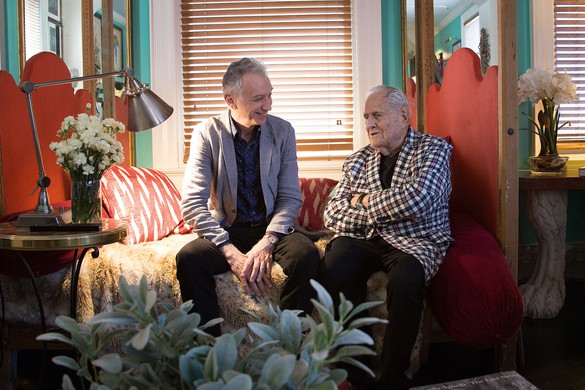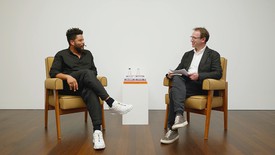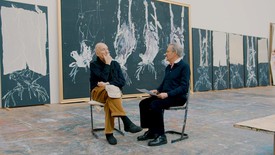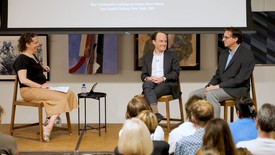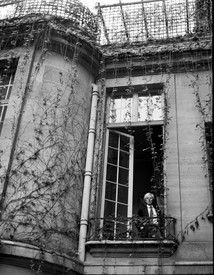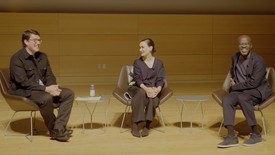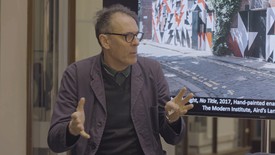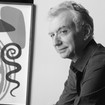
Jed Perl was the art critic for The New Republic for twenty years and a contributing editor to Vogue for a decade. He is currently a regular contributor to The New York Review of Books. Among his many books are Calder: The Conquest of Time, Magicians and Charlatans, Antoine’s Alphabet, New Art City, and Paris Without End. He has written for Harper’s, The New Criterion, The Yale Review, Salmagundi, and many other publications. He is the recipient of a Guggenheim Fellowship and teaches at the New School in New York. Photo: Duane Michals
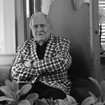
Sir John Richardson (1924–2019), son of Sir Wodehouse Richardson, was born in London. He studied at the Slade School of Fine Art, then began writing for the New Statesman, Burlington Magazine, and other British journals. In 1950 he and the modern art collector and scholar Douglas Cooper moved to a château in the south of France, where Picasso was a frequent visitor. In 1980 Richardson began writing A Life of Picasso. The first volume was published in 1991, the second in 1996, the third in 2007, and the fourth in 2021. He was appointed Slade Professor of Art at Oxford in 1995 and knighted by H.M. the Queen in 2012. Photo: Brian Gilmartin
Jed Perl I went back to the beginning of the first volume of your biography of Picasso, where you said a few things about the art of biography.
John Richardson Oh dear, did I?
JP I’m going to read you something you wrote back then. It interests me greatly—as you know, I’ve been working on a biography of Alexander Calder for ten years, and I’ve become fascinated by the whole question of biography and how one interprets an artist. This is what you wrote: “Picasso was such a mass of contradictions that according to his son, he used to repeat again and again, ‘Truth is a lie. Truth is a lie.’ No wonder so much of what has been said about Picasso turns out to be equally true in reverse. Since quicksilver would be easier to nail down than his precepts, methodologies have proved unequal to the task. I have therefore tried wherever possible to respect this ambivalence, to present the artist’s life inside and outside the studio in the light of it.”
I think you’re making a very important point here, about the limited usefulness of methodologies.
JR I think what I wrote there holds up.
JP I agree. And this leads us to an important question: What guides the biographer if not some fixed methodology? How do you proceed? I think we share an approach to these questions that is more intuitive than anything else. And I think many people have a certain embarrassment with the idea that one might be intuitive about the connection between events in the life and something in the work. It seems to me that part of your great gift as a biographer has been to be intuitive about these questions.
JR Well, I think I had to be intuitive because I’m self-educated, essentially. I’m not an academic. I went to a public school in England but I left it when I was fifteen, and then I went to art school at the Slade. So I didn’t end up with the typical English education in the classics that I would have had I gone to Oxford or Cambridge. Instead, I’ve been able to approach the subject of art and artists with a training in fine arts rather than a background in classical scholarship. And I think that probably was an advantage [laughs]. I didn’t approach my writing with a whole lot of preformed ideas, whether good or bad. I hadn’t been taught all this methodology, you know—so I had the freedom to cobble together my own process and develop my own readings from books and picking it up in the streets and conversations with a few people, but I didn’t have much formal training. But in a funny way, my writing was probably fresher, because I didn’t have a stock of stuff at the back of my mind. I mean, I wrote about what I felt.
JP Right. You didn’t come at it with preconceptions.
JR No. I didn’t think, “Oh my God, so-and-so wrote all about this and I should really take that into consideration.” I hadn’t read any of the great art historians or theorists. I was free of all that. So it all depends on my own experience.
JP For several years after I started working on my Calder biography—that was a decade ago—I felt I didn’t know how to evaluate a lot of the information. There are still many people alive who knew Calder. People would tell me stories and I had no idea, for the first three or four years, whether the stories I was hearing were important or unimportant. But at some point, after five or six years of working, I began to develop what I felt was almost a sixth sense. I began to feel that I understood something about Calder’s mind; I had a sense of when he was saying things that were important and when he was saying things that were disingenuous, maybe playing the trickster with people who were interviewing him. Do you know what I mean?
JR Yes, I do. Picasso is slippery in that way too.
JP But it took a long time to get to that point. It must have been different for you, because you knew Picasso quite well.
JR Yes, quite—in the end, very well.
JP How did knowing him in some of his later years shape your understanding of the earlier years? How did that affect you as you began to write the biography?
JR What I enjoyed most about visits to Picasso was the opportunity to study the recent work with the artist. Not that he cared so much about his friends’ comments; what he really wanted was a shot of their energy. On one of my earliest visits he had shown me some drawings. When I shyly tried to explain what impressed me about one of them, he was surprisingly responsive. Three months later, on another studio visit, I was amazed to find that he had taken this particular drawing out of its portfolio to have another look at it. That Picasso should have cared enough to remember was astonishing—tears welled up in my eyes. The third time he played this trick, I realized it wasn’t my opinions he valued, it was the tears he squeezed out of me. It was proof that his magic still worked. Once I caught on to this, I’d watch him manipulate anyone who seemed vulnerable into an emotional response to his work. He would switch on the magnetism and let his ego feed on whatever admiration or devotion could be extracted from those around him. At the end of the day, Picasso would have made off with everyone’s energy; it would fuel a night of work in his studio while the rest of us lapsed into nervous exhaustion.
What guides the biographer if not some fixed methodology? How do you proceed? I think we share an approach to these questions that is more intuitive than anything else.
Jed Perl
JP One thing I find myself wondering about a lot now—and it’s certainly relevant to the art of biography—is whether there are kinds of information about a person, private or intimate facts, that shouldn’t be shared, even after a person has died. There was a time, not too long ago, when there were certain lines that you didn’t cross in a biography. What happened in the bedroom was not discussed, right?
JR I remember that.
JP There were things that might be discussed quietly, among friends, but not out in public—and to some degree biographers followed those conventions. Today, of course, there’s hardly anything that isn’t discussed in public. What I’m wondering is how the shrinkage of what used to be a private realm affects the work of the biographer. One of the chapters I greatly admire in the third volume of your Picasso biography is the chapter where you turn to Marie-Thérèse Walter. You do something very interesting: you step back from what would be regarded as a straightforward narrative and instead begin by writing about the interviews that Marie-Thérèse gave late in life.
JR That’s right, yes. Thanks to a brilliant scholar named Lydia Gasman, who has passed away now—she shared these interviews with me, which were intimate to say the least.
JP And you talk about how frank she was in those interviews, as a way of giving us a pretty good idea of what the sex between her and Picasso was like. But you don’t exactly do it as part of the narrative—in your own words. The chapters before and the chapters after this are conceived in a more “conventional” way. I liked that you changed your approach when you turned to the intimate details of Picasso’s affair with Marie-Thérèse; it was as if you handed over the story to her, you allowed her to tell it in her own words. And you showed us that she was willing to speak about these intimate matters. I’m left wondering if there are things that you know about Dora Maar and Picasso, or Françoise Gilot and Picasso, that you might not put in a book?
JR In Dora’s case I left out a lot of personal stuff. I mean, I was very close to Dora and I didn’t want her to think that I was just a shitty guy who wanted to get all the dirt he could and write about it. There was a line that I didn’t really want to cross. Also, I wanted to go as far as I possibly could without offending Picasso’s family, or writing something that somebody else might get hold of and turn into something completely different. I was also very close to Picasso’s friend and rival Georges Braque, but there was nothing scandalous about his private life. Braque’s private life is seldom reflected in his work.
JP With Calder as with Braque—they were friends—there was nothing scandalous about the private life. But I’ve still found myself wondering how far to take certain lines of inquiry—whether that’s the few details we have about Calder’s romantic life before he married Louisa James, or the details of medical records that have remained with the Calder family. I find myself wondering if there are conventions of privacy even now that a biographer should be respecting. What you’re saying, and I think you’re absolutely right, is that the decision to discuss certain private matters must be justified by the possibility of illuminating the creative process.
JR Exactly, yes.
JP So even today, we could say that a detail in a biography is prurient if it’s merely there to show that you know it or can play gotcha. It’s prurient until—unless—it actually helps to illuminate the artist and the art.
JR Yes. Well, I’ve given these things a lot of consideration and I think that on the whole, I hope in the case of Picasso that I’ve never been prurient. If I felt that anything was, I would chop it out immediately. I’m trying to think of other people I’ve written about, if I’ve let all the cats out of the bag. I don’t think so.
JP For me, many of the biographies of visual artists are pretty weak; your Picasso is one of the great exceptions. People are sometimes surprised, when they ask what biographies I admire, to hear me talk about biographies of creative people other than visual artists. I’m a great admirer of Richard Ellmann’s biography of James Joyce and Leon Edel’s of Henry James. I’m wondering, when you started to think about biography, were there biographers you thought about?
JR Many biographies I read were so full of gas and gossip and names of great thinkers who were cited and whose words just created a lot more gas. As far as I was concerned, what you want to do as a biographer is try and tell, as clearly and sharply as you can, what you know and what you perceive. Occasionally, I would feel I was way off the mark, but on the whole, I’d like to think I was okay. And I’m not a—you know, I was going to say I’m not an intellectual, but I suppose in the end I am to some extent.
JP Yes. Oh, you are very much an intellectual.
JR But I was never an academic, I think that’s the main thing. I went from art school straight to earning my living. There was a great deal I hadn’t yet considered, in terms of philosophers, etcetera. So I was open to a great many things.
JP Well, I guess we have that in common, because after college I went to art school—I have an MFA in painting and I don’t have a PhD. I think sometimes people decide that being an intellectual is knowing all the answers, when in fact, I think really being an intellectual is having a mind that is playful and willing to look at different sides of things.
JR I absolutely agree with you on that.
I think one should always question things, question things, question things, and not settle back and sort of be smug and say, well, it’s all nice and it’s all jotting along, everything makes sense. It doesn’t. Everything never makes sense and shouldn’t make sense.
John Richardson
JP I very much admire the close of the third volume of your biography, when you bring in Carl Jung’s critical writing about Picasso, and although what Jung says is anything but sympathetic, you confess to finding it very interesting. What you show us is that although Jung is knocking Picasso, he’s actually getting at interesting things about him. What you demonstrate there is that there’s such a thing as a play of ideas, and that in fact, even something thumbs down can be illuminating if it gets at some deeper truth—a truth we can only get at when we reject a fixed agenda, right?
JR Yes. Initially I had a problem, because I didn’t think that I was nearly clever enough to write on artworks and artists—to come out with opinions and so on. My best friend was the philosopher Richard Wollheim. I’d known him since I was sixteen or seventeen, and we remained friends throughout our lives. And Richard was so intelligent and so well read in different fields. He was a key figure in my life in that he did sort of hover round and say, “Well, John, you really should read this,” and he would explain things to me. But you’re right, a fixed agenda was never part of my general process.
JP Something else I very much want to discuss with you—and in a sense it’s a philosophical matter—is the great question of whether there is a unity to Picasso’s work. You said something about the 1980 Picasso retrospective that William Rubin mounted at the Museum of Modern Art that I find amusing and spot-on. You wrote, in the New York Review of Books, “The pattern of stylistic infidelity can be said to follow the pattern of amorous infidelity” [laughter].
JR Oh, that’s rather profound [laughter].
As far as I was concerned, what you want to do as a biographer is try and tell, as clearly and sharply as you can, what you know and what you perceive.
John Richardson
JP You also said—of both the Rubin show and the Picasso show that Dominique Bozo had mounted previously in Paris—that “they have emphasized the continuity of Picasso’s development.” You then went on to suggest or imply that this might give a spurious logic to the oeuvre. Do you think there’s a unified logic to that development? You know, Meyer Schapiro wrote a long essay in which he said people talk about unity as a virtue and wondered where that left Picasso’s work. Schapiro argued that transformation—a perpetual process of transformation—was the unifying principle in Picasso’s art. What’s your view? Is it just stylistic infidelity, or is there a deeper—
JR Oh, I think there’s a much deeper logic to Picasso’s genius.
JP And what is that? How would you characterize that unity?
JR God knows. I think he just had that extra amount of—it certainly wasn’t knowledge, but a sensitivity, a sensibility, so that he could sort of see the pattern in the carpet that nobody else could see. That’s rather inadequate, but I mean—
JP Are you saying, then, that all the stylistic variety fits into some pattern?
JR No, I wouldn’t say that, but I can see how these different aspects of Picasso’s work relate to each other and very often antagonize each other. I mean, they don’t always end up saying the same thing. Not at all. And I think one has to see this as sometimes a sort of fight between one way of thinking and another. And this is a good thing and it keeps things alive and it keeps arguments going, which I think is very important.
JP You’re saying that there’s some dynamic or almost dialectical unity to the work, which puts it all in a chain of some kind of—
JR Yes, but it also fails—
JP Fails—okay. But that impulse—
JR That impulse, yes.
JP There’s an impulse that lies behind everything Picasso did. And that’s important, because eclecticism has been one of the points of attack against Picasso.
JR Yes. I mean, it’s mistrusted by virtue of being what it is.
JP Right. Well, there’s a problem that can at least in part be blamed on Clement Greenberg. There’s a sort of standard-issue modernism—I think it’s still taught—that goes back to Greenberg’s idea that modern art is defined by a push toward ever greater purity. Since I was a kid, I’ve known that this doesn’t jibe with the work of Picasso—or Braque or Henri Matisse. It doesn’t even jibe with Piet Mondrian, whose work becomes more complicated and in a way related to nature in his last days. So it’s a very strange thing, this idea of modernism as a kind of purism.
JR Well, that’s what they wanted it to be, I think. I mean, a whole lot of people tried to find ways of making it all make sense and fit tidily together. And, needless to say, it’s nothing like that at all. What I like is sort of not trying to gather all the bits together and getting them to make sense and make a lovely jigsaw puzzle. I like it all still alive, still touching people in very different ways and having very different results. I’m always interested in the ways that people’s views over the years change, and in a way they change the original statement—it doesn’t have the force it once had, but it’s got another kind of force according to what’s happened in the world or what’s happened in philosophy or whatever it is. I think one should always question things, question things, question things, and not settle back and sort of be smug and say, well, it’s all nice and it’s all jotting along, everything makes sense. It doesn’t. Everything never makes sense and shouldn’t make sense.
JP Yes. One of the things I love about Calder is that his work doesn’t take a straight path—he does his purest, most simplified abstractions in the very early 1930s and then he complicates things later on, and there are even phases toward the end of his life where he returns to figures and images that are related to what he was doing in the 1920s. And of course this horrifies purists who think an artist is supposed to be on this sort of one-way train. But this is one of the things I love about Picasso, that he goes in one direction and then another. And then I think of Suite 347, of 1968, and the narrative richness there at a time when that’s all supposed to be over in the history of art—
JR Yes, it’s all this narrative stuff—people were shocked by this. I mean, gallery-goers wanted the artist to be faithful to one vision, and if the artist went ahead and suddenly went in a different way, oh dear, they couldn’t follow that. And I understand that. I mean, you do need to have a specific kind of mind to take in these extraordinarily abrupt changes that these great artists were making.
JP Well, there’s the whole question of Picasso’s response to the world around him, it’s a fascinating kind of dynamic. I mean, how do you—
JR God knows how [laughter]—I mean, I was really close to Picasso, he was incredibly warm and generous to me, but looking back on it, I still don’t fully understand him. He’s too big to understand. And I think that if you try to make a coherent view of all this, you figure out it’s not possible. Picasso was exceptional, he made these amazing leaps, and if you try to put them all in a neat row, it doesn’t really work.
JP You’re saying there’s no one key. You know, people often want to have this sort of “Rosebud” moment, the famous childhood sled in Orson Welles’s Citizen Kane—the clue, so it’s suggested, that will explain the whole life. People want to have that one key that unlocks everything, right? That doesn’t seem to me to be very much the way life really is. It seems to me most of us—and I’m not talking at the moment about genius, but just us mere mortals—are made of many things with many different sides.
JR Yes. And it is seldom that we make that leap. You know, it’s easier to go on doing what we’ve done before. Those leaps take a lot of strength.
Photos: Brian Gilmartin
